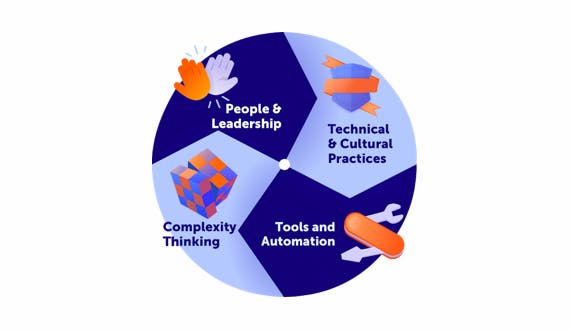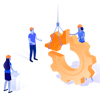In this blog series, Heidi Araya, Agile Transformation Leader and creator of the Four facets of agility, unpacks the roadblockers inherent with agile transition and explains how our four facets of agility help organisations to see agile differently. Previous posts have covered complexity thinking, people and leadership, and technical and cultural practices. Here, she explores the final facet: tools and automation.
The tools we choose should help organisations to achieve great things. They’re there to provide visibility into the pipeline of product delivery so teams and organisations can understand and improve based on what they’re seeing. And automation is vital too - agility is about automating what is possible to reduce risks and errors from manual work.
Organisations need to look at these components holistically, rather than each department leader making decisions independently and focusing simply on “their part”. And they need to continuously improve the tools and automations they have in place.

Tooling around
Conway’s Law states that we design systems that mirror our own communication structure. Without cross-company tools that foster clear, concise, and meaningful communication, the software an organisation produces will lack that same cohesion and fail to deliver what customers need. Adaptavist works with clients to audit and evaluate the tools and existing configurations for teams and workflows and, along with a cross-section of people in the organisation, align existing tooling and processes with the value stream.
When we’re called in to assess a tooling set-up, we often find that people have no holistic view of what is actually going on inside the company, or how it actually delivers anything to customers. Perhaps there are many different tools being used by different roles (product managers use one tool; testers use another tool; and engineers another, for example); or short-lived project teams and multiple handoffs across different departments. Project teams are often based on the thinking that people can be assigned to multiple projects so they are fully allocated, and furthermore are easily swappable across teams, which is not congruent with reality.
One team we worked with had a 12-column Scrum board. It included an engineer, peer code review, senior code review, and three kinds of QA testing, but there were still a high number of production incidents. They were even hiring a release manager to try to prevent things from being released to production in a bad state. Every time something went wrong, they added tools, processes, and people, rather than fixing the underlying problem (a lack of automated testing). No surprise - not only was this expensive - it didn’t solve their problems at all.
Measuring for success
When tools aren’t set up right, collaboration is negatively impacted. Teams need a holistic view of value delivery, clearly stated goals, and a vision for tooling solutions to help realise their full potential (but don’t make this into another waterfall project plan - it is important, above all, to start somewhere and iterate).
Effective tools also provide the information organisations need to make fact-based, strategic decisions. Problem is, often people don’t know what they should be measuring, how, or why. We look beyond standard tooling using ‘flow metrics’ – measuring the movement of value right to the customer to close the feedback loop – assessing cycle time, throughput, and time in status as well as other “healthy metrics” that can be used to help teams - and the enterprise - improve.
Scaling up your tooling strategy
Even with the best agile intentions, poor tooling will curtail any noticeable benefits. Are your software products more complex than the development tools you’re using? Have you adopted SAFe® and other scaled agile frameworks but can’t coordinate your value streams? Or are you struggling to marry up the work with your strategy or value delivery? If the answer to any of these is yes, you’re not alone.
Good tools offer the benefits of agile development – helping teams improve collaboration, and providing transparency into enterprise initiatives. Beyond that, they provide insight outside the team level, offering visibility at scale for large enterprises. It is important that scaled agile tooling solutions are both flexible and pragmatic to meet the needs of organisations who want to leverage and track value across teams and programs. Scaled agile tooling should be able to help you achieve the following:
- Understand the delivery of end-to-end value to customers.
- Tie strategy to execution, so that your people understand the ‘why’ and feel like they’re working on things that matter.
- Be able to plan online – with distributed teams now the norm, this is more important than ever.
- Make better decisions using real-time data.

Tools down?
If your tools are taking their toll on your productivity, scalability, and visibility, it might be time to call in the experts. Contact our experts to discover how transforming your tools can accelerate your agile transformation today.
Unlocking the four facets of agility
Rather than agile being an empty word, naming these four aspects – complexity thinking, people and leadership, technical and cultural practices, and tools and automation – has helped us think differently about agile transitions. Now we have more meaningful, productive conversations about the needs and challenges faced by our clients.
Our workshops and discovery sessions help the entire team identify next steps, instead of executives dictating them without context. Work is done incrementally, in a transparent way, with purpose and clearly defined outcomes. Input from everyone allows the right tools and processes to be introduced with maximum buy-in. And, as a result, culture improves. Arming teams with this wider knowledge promotes autonomy, increases productivity, raises engagement, and bakes in complexity thinking.
These learnings aren’t just for our clients – we’re applying them at Adaptavist too. The ultimate goal of agile is to become a ‘deliberately developmental organisation’ – embracing learning, continuously addressing processes and tools, and analysing and adapting your culture and thinking as you go. As a result, you can expect improved well-being, an increase in team and organisational performance, and a workplace where it’s not just about getting the job done; it’s about caring how it gets done.
Ready to face the four facets head on?
From developing an agile mindset to ensuring you have the right tools for the job, rewiring the way you work is complex and continuous. Adaptavist’s experts are here to help—just fill out this form and we'll get back to you.







